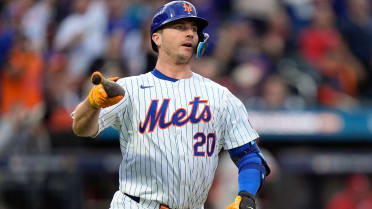Who will make the Hall? Classic Baseball Era results tonight (7:30 ET, MLB Network)
Expect a big announcement on Sunday at the MLB Winter Meetings in Dallas. The Classic Baseball Era Committee will meet that day to determine whether any of the candidates on an eight-name ballot will be inducted into the National Baseball Hall of Fame in July.
Five position players and three pitchers comprise the CBE ballot, which focuses on candidates who contributed to the game prior to 1980, including Negro Leagues and pre-Negro Leagues stars. The ballot includes Dick Allen, Ken Boyer, John Donaldson, Steve Garvey, Vic Harris, Tommy John, Dave Parker and Luis Tiant.
Any candidate who receives a vote from at least 12 of the 16 committee members (75% required) will earn induction. The results will be announced live on MLB Network at 7:30 p.m. ET on Sunday.
Dick Allen, 3B/1B
Allen played 15 years (1963-77) in the Major Leagues, mostly with the Phillies and White Sox, made seven All-Star appearances and won the American League Most Valuable Player Award in '72. Allen's FanGraphs OPS+ (156) is the highest in Phillies history, ahead of Hall of Famer Mike Schmidt, matching Willie Mays and Frank Thomas and tied for 14th among players with at least 7,000 plate appearances. From 1964-74, Allen was first in MLB in offensive WAR (68.3), according to MLB Network, ahead of Hank Aaron, Frank Robinson, Carl Yastrzemski and Joe Morgan. Allen ranks 208th in career bWAR (58.7), ahead of Hall of Famers Enos Slaughter, Willie Stargell and Tony Perez.
Significant moment: Imagine if Statcast had been around when Allen played. He was known to use a 42-ounce bat and hit monster home runs. Some of those bombs were legendary. According to Baseball Almanac, Allen hit 18 home runs that cleared Connie Mack Stadium's 65-foot-high left-field grandstand. Also according to the website, Allen twice cleared the park's 65-foot-high right-center-field scoreboard.
Ken Boyer, 3B
Boyer played for 15 years, and most of his success was with the Cardinals from 1955-65. Boyer was an 11-time All-Star, won four National League Gold Glove Awards and had the season of a lifetime when he won the NL Most Valuable Player Award in '64 and helped St. Louis beat the Yankees in seven games to win the World Series. His bWAR is 62.8, higher than Hall of Famers Harmon Killebrew (60.3), Yogi Berra (59.5) and Mike Piazza (59.5).
Significant moment: Game 4 of the 1964 World Series at Yankee Stadium with the Yankees leading the Series, 2-1. The Cardinals were down, 3-0, until Boyer turned the game around in the sixth inning with a grand slam off left-hander Al Downing. It proved to be the difference as the Cardinals won the game, 4-3, and went on to win the World Series.
John Donaldson, LHP
Long before Satchel Paige and Don Newcombe made their marks in the Negro Leagues, Donaldson was the most dominant pitcher in the early 20th century. According to Bob Kendrick, president of the Negro Leagues Baseball Museum, Donaldson is known to have invented the slider, and it made him a dominant pitcher. According to Negro Leagues historian Pete Gorton, Donaldson won 413 games, struck out 5,091 batters and pitched 14 no-hitters -- two of them perfect games. Donaldson has been overlooked to date because he pitched in the early era of Black baseball, prior to 1920 when the Negro National League was formed. Most players from the Negro Leagues were not recognized until the '30s and '40s, when Buck O’Neil and Josh Gibson made their marks on the diamond. Donaldson was considered a hired arm during his career, having played for 25 teams, including the Tennessee Rats, the Missouri Hannaca Blues and the Indianapolis ABCs.
Significant moment: While playing for Kansas City's All-Nations team in 1915, Donaldson pitched 30 consecutive innings without allowing a hit. “We have all this quantitative data on John Donaldson,” Kendrick said. “We have all the incredible feats that we have never really seen done in this game prior to Donaldson."
Vic Harris, OF/1B/manager
Harris made his mark as a player/manager with the Homestead Grays. According to Seamheads.com, Harris was a career .305 hitter with a 114 OPS+. He was given the nickname Vicious Vic due to his aggressive style on the baseball field. He was the Pete Rose and Hal McRae of his time. Harris' managerial success goes without saying. While managing the likes of Buck Leonard, Oscar Charleston and Smokey Joe Williams, Harris guided the Homestead Grays to seven pennants and the 1948 World Series title in the Negro Leagues.
Significant moment: The Grays were the last team to win the Negro League World Series, defeating the Birmingham Black Barons -- a team that featured Mays -- in five games. The Series looked like it might go the distance after the Barons won Game 3, 4-3, but the Grays won the next two games and the series by outscoring Black Barons, 24-7.
Steve Garvey, 1B
Like his mentor Gil Hodges, Garvey became an All-Star first baseman, mostly with the Dodgers. Garvey started his big league career as a third baseman but settled in at first base and broke out in 1974, winning the NL MVP Award. Garvey, a 10-time All-Star, ranks 17th in Dodgers history in bWAR (36.6). That’s ahead of Roy Campanella (35.6), another Hall of Famer. Garvey also holds the NL record for consecutive games played at 1,207.
Significant moment: It came as a member of the Padres in the 1984 NL Championship Series, and Garvey had a series to remember against the Cubs. He earned MVP honors by going 8-for-20 (.400) with a home run and seven RBIs. Garvey’s biggest hit came in Game 4, when he hit a two-run homer in the bottom of the ninth to give San Diego a 7-5 victory and tie the series at 2. The Padres won the pennant the next day.
Tommy John, LHP
John's fastball was clocked no higher than 90 mph, but he still managed to win 288 games and had a respectable 3.34 ERA while playing for six teams including the Dodgers, Yankees and White Sox.
“If he doesn't get picked to the Hall of Fame, it’s going to be an absolute tragedy,” Dodgers teammate Joe Ferguson told MLB.com in March. “This guy was one of the best pitchers in the Major Leagues for a long time. He had a tremendous career.”
Significant moment: On Sept. 25, 1974, John was the first to get the elbow ligament construction that is now named after him. It took John a year and a half to return to the mound. He pitched his first game after surgery on April 16, 1976, against the Braves and was one of the Majors’ most consistent pitchers, winning 164 games over the next 14 seasons. In fact, John notched more wins after the surgery than before (124). As of Wednesday, 2,547 Tommy John surgeries have been performed on the elbows of professional baseball players, according to baseball analyst and journalist Jon Roegele, who maintains a list of those who have had the procedure.
Dave Parker, OF
Known as "The Cobra," Parker was an intimidating force when he wielded a 37-ounce bat during the 1970s and '80s for six Major League teams, including the Pirates, Reds and Athletics. Besides winning two batting titles, an NL MVP Award, three NL Gold Glove Awards and three NL Silver Slugger Awards, Parker played 19 years in the big leagues, hitting .290 with 339 home runs and 1,493 RBIs. He was the Designated Hitter of the Year in 1989 and '90.
Significant moment: Parker had a cannon for an arm -- the same arm that threw out Jim Rice and Brian Downing in the 1979 All-Star Game, earning Most Valuable Player honors. It proved to be the difference as the NL edged the AL, 7-6.
Luis Tiant, RHP
Known for his eight years with the Red Sox, Tiant was one of the best pitchers in the AL for more than a decade. For example, Tiant’s best season came as a member of the Indians in 1968 when he won 21 games and led the AL with a 1.68 ERA. Tiant’s career in the Major Leagues lasted 19 years, and finished with 229 wins with a 3.30 ERA in 573 games.
Significant moment: Tiant became nationally known because of Game 1 of the 1975 World Series. His whirling, twisting delivery gave the Reds fits in a 6-0 victory. He twirled a five-hit shutout and even helped his own cause by going 1-for-3 with a run scored. He led off during a six-run seventh inning and singled to left field. He later scored the first run of the game on a Yastrzemski single.
Bill Ladson has been a reporter for MLB.com since 2002. He covered the Nationals/Expos from 2002-2016.




